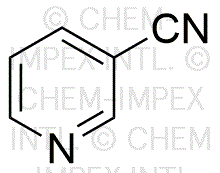3-Cyanopyridine is widely utilized in research focused on:
- Synthesis of Pharmaceuticals: This compound serves as a key intermediate in the production of various pharmaceuticals, including anti-inflammatory and anti-cancer agents, enhancing drug efficacy and targeting specific biological pathways.
- Agricultural Chemicals: It is used in the formulation of agrochemicals, such as pesticides and herbicides, contributing to improved crop protection and yield, which is essential for sustainable agriculture.
- Organic Synthesis: Researchers employ 3-Cyanopyridine in organic synthesis for creating complex molecules, benefiting industries like materials science and nanotechnology through innovative material development.
- Analytical Chemistry: This compound is utilized in analytical methods, such as chromatography, to detect and quantify various substances, aiding quality control in chemical manufacturing and environmental monitoring.
- Ligand Development: In coordination chemistry, it acts as a ligand in metal complexes, which are crucial for catalysis and material science, offering advantages in reaction efficiency and selectivity.
General Information
Properties
Safety and Regulations
Applications
3-Cyanopyridine is widely utilized in research focused on:
- Synthesis of Pharmaceuticals: This compound serves as a key intermediate in the production of various pharmaceuticals, including anti-inflammatory and anti-cancer agents, enhancing drug efficacy and targeting specific biological pathways.
- Agricultural Chemicals: It is used in the formulation of agrochemicals, such as pesticides and herbicides, contributing to improved crop protection and yield, which is essential for sustainable agriculture.
- Organic Synthesis: Researchers employ 3-Cyanopyridine in organic synthesis for creating complex molecules, benefiting industries like materials science and nanotechnology through innovative material development.
- Analytical Chemistry: This compound is utilized in analytical methods, such as chromatography, to detect and quantify various substances, aiding quality control in chemical manufacturing and environmental monitoring.
- Ligand Development: In coordination chemistry, it acts as a ligand in metal complexes, which are crucial for catalysis and material science, offering advantages in reaction efficiency and selectivity.
Documents
Safety Data Sheets (SDS)
The SDS provides comprehensive safety information on handling, storage, and disposal of the product.
Product Specification (PS)
The PS provides a comprehensive breakdown of the product’s properties, including chemical composition, physical state, purity, and storage requirements. It also details acceptable quality ranges and the product's intended applications.
Certificates of Analysis (COA)
Search for Certificates of Analysis (COA) by entering the products Lot Number. Lot and Batch Numbers can be found on a product’s label following the words ‘Lot’ or ‘Batch’.
*Catalog Number
*Lot Number
Certificates Of Origin (COO)
This COO confirms the country where the product was manufactured, and also details the materials and components used in it and whether it is derived from natural, synthetic, or other specific sources. This certificate may be required for customs, trade, and regulatory compliance.
*Catalog Number
*Lot Number
Safety Data Sheets (SDS)
The SDS provides comprehensive safety information on handling, storage, and disposal of the product.
DownloadProduct Specification (PS)
The PS provides a comprehensive breakdown of the product’s properties, including chemical composition, physical state, purity, and storage requirements. It also details acceptable quality ranges and the product's intended applications.
DownloadCertificates of Analysis (COA)
Search for Certificates of Analysis (COA) by entering the products Lot Number. Lot and Batch Numbers can be found on a product’s label following the words ‘Lot’ or ‘Batch’.
*Catalog Number
*Lot Number
Certificates Of Origin (COO)
This COO confirms the country where the product was manufactured, and also details the materials and components used in it and whether it is derived from natural, synthetic, or other specific sources. This certificate may be required for customs, trade, and regulatory compliance.


